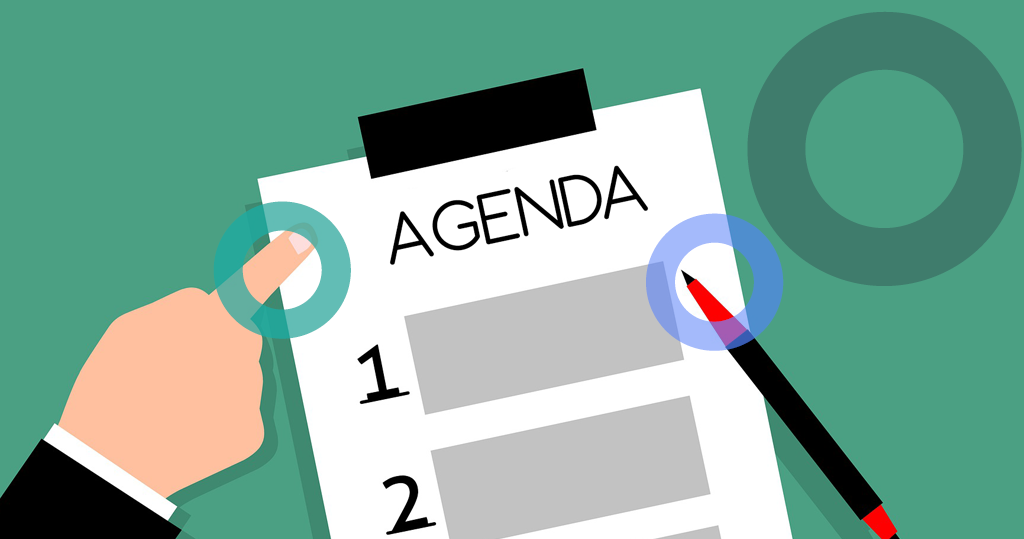10 Agenda Design Tips For Effective Meetings

Is your team struggling to have effective meetings? Are people not showing up prepared, or worse, not showing up at all? If so, it might be time to rethink your meeting agenda design.
An agenda is a roadmap for your meeting. It should be clear and concise, outlining the topics to be discussed and the order in which they will be addressed. This will help keep everyone on track and ensure that the meeting progresses efficiently.
In this article, we will discuss ten tips for designing effective meeting agendas for your next meeting.
What Are the Key Components of an Agenda?

There is no one-size-fits-all answer to this question, as the key components of an agenda will vary depending on the business organization or project. However, there are some general guidelines that can be followed to create an effective agenda.
Some of the key components of an agenda may include:
- The attendees
- The goal or objective of the meeting
- The topics that will be covered
- The time allotted for each topic (so called time boxing)
- Any materials that need to be prepared ahead of time
- Any other pertinent information
Overall, an agenda should be clear, concise, and easy to follow. An effective agenda can be a valuable tool for business or project success.
10 Agenda Design Tips For Effective Meetings
Here are ten agenda design tips to help you create effective meetings:
1. Keep it Simple
When it comes to agenda design options, one of the most important things to remember is to keep it simple. This means that your agenda should be easy to understand and follow. When meetings are run effectively, everyone involved will be able to stay on track and accomplish their goals.
There are a number of ways to create a simple agenda. One option is to use free agenda templates. An agenda template will give you a basic framework that you can customize to fit your specific needs. Another option is to keep your agenda items brief and concise. This means avoiding long paragraphs and instead focusing on key points.

2. Structure the Agenda Around Key Topics
When it comes to agenda design, structuring the agenda around key topics is one of the most effective tips for ensuring that meetings are effective and productive.
By focusing on the key topics that need to be addressed, meeting participants will be able to stay on track and get the most out of the discussion. There are a few ways to go about structuring the agenda around key topics:
- List out the key topics and then order them based on their priorities. This is the most common approach, as it allows participants to easily see what will be discussed and in what order.
- Group related topics together. This approach can be helpful when there are a lot of topics to cover or when some of the topics are more complex than others.
- Assign each topic to a specific person or group. This is a good option when there are multiple stakeholders involved in the discussion.
- Select one key topic and then design the agenda around that. This can be a good option when there is a particularly important issue that needs to be addressed.
No matter which approach you take, structuring the agenda around key topics is an effective way to ensure that meetings are productive and efficient. By taking this step, you can make sure that everyone is on the same page and that the discussion stays focused on the most important issues at hand.
3. Seek Input From Other Team Members
Seeking input from other team members is an essential aspect of good agenda design. This allows for a variety of ideas and perspectives to be brought to the table, which can help to make meetings more productive and efficient. Not only will this help to ensure that everyone has a voice, but it can also help to avoid any misunderstandings or conflicts.
When seeking input from the whole team, it’s important to be specific about what you’re looking for. Ask them to provide feedback on the items that will be discussed at the meeting, and be sure to give them enough time to prepare. You may also want to consider sending out an agenda ahead of time so that everyone is aware of what will be discussed.
4. Prioritize Clearly-Laid Out Steps
When creating an agenda, it’s important to prioritize the steps that need to be taken in order to achieve the meeting’s goal. This will help ensure that everyone is on the same page and that the meeting flows smoothly. Having a clearly-defined order of operations will also help to keep the meeting on schedule and prevent it from dragging on for too long.
Some tips for prioritizing steps include:
- Define what the goal of the meeting is and list out the steps needed to achieve it
- Place the most important steps at the top of the agenda
- Group related steps together
- Use headings and subheadings to organize the agenda
By taking these steps, you can create an agenda that is clear, concise, and easy to follow. This will help ensure that the meeting is productive and accomplishes its goal.
5. Facilitate Discussion and Decision Making
When designing your meeting agenda, it’s important to focus on facilitating discussion and decision-making. This will help ensure that your meeting is productive and efficient. There are a few things you can do to facilitate discussion and decision making:
- Make sure that everyone has a chance to participate. Don’t let a few people dominate the discussion.
- Establish a clear agenda and stick to it. This will help keep the meeting on schedule and prevent it from running off course.
- Encourage open communication and debate. This will help participants to better understand the issues at hand and make informed decisions.
- Be prepared to make decisions. If possible, try to come to a consensus rather than simply voting on proposals.
- Encourage open communication and debate. This will help participants to better understand the issues at hand and make informed decisions.
By facilitating discussion and decision-making, you can ensure that your meetings are productive and effective.

6. Include Action Items
One of the most important aspects of any meeting is ensuring that action items are identified. Including a section for follow-up measures on your meeting agenda ensures that everyone is aware of what needs to be done and by when. It also helps to ensure that no important tasks are forgotten.
When creating action items, be sure to:
- Clearly identify the task
- Indicate who is responsible for completing the task
- Set a deadline for completion
Including these items on your meeting agenda is an essential way to ensure that your meetings are effective and productive.
7. Take Advantage of a Meeting Management Platform

A meeting management platform can be an extremely valuable tool for effective meetings. It can help to keep everyone on track and make sure that all necessary information is communicated.
Some meeting management platforms come with amazing free agenda templates, which can make designing an effective meeting agenda much easier.
For example, yowork is a great meeting management platform that comes with a free agenda template library, offers shared agendas for teams, and has an Agenda Health Check feature. Using yowork can help you to take your business meetings to the next level by ensuring that all necessary information is communicated and everyone stays on track.
8. Be Flexible
Being flexible is of utmost priority when it comes to meeting agendas. This means that you should always be prepared to change the order of items on the agenda or to add or remove items, depending on what is happening during the meeting. You should also be prepared to modify the time frame for the meeting if necessary.
This flexibility can help you to deal with unexpected situations that may arise during the meeting, and it can also help to keep the meeting on track. If everyone knows that they can change the agenda as needed, it will help to keep them calm and focused during the meeting.
9. Set a Timeframe for Each Agenda Item

One way to make sure that your meetings are as effective as possible is to set timeframes for each agenda item. This will help to keep everyone on track and ensure that the meeting stays focused. When you’re setting timeframes, be realistic about how much time each item will take. You don’t want to rush through important items, but you also don’t want the meeting to drag on for hours.
If you’re having a difficult time sticking to a timeframe, try using an agenda template. This will help ensure that all of the important items are discussed. You can also save this agenda template and reuse it in future meetings.
10. Make Notes and Follow Up After the Meeting
Once the meeting is over, it’s important to follow up with all of the participants. This means sending out an email or document that includes all of the important points that were discussed. It’s also a good idea to make notes about what was discussed and what needs to be done next.
Making notes after the meeting is a great way to ensure that you don’t forget anything important. It’s also a good way to remember what needs to be done and when.
Wrapping Up
Designing an effective agenda for your next meeting is a great way to ensure that it runs smoothly and achieves its objectives. By following the tips we’ve outlined in this article, you can create an agenda that will help make everyone feel more involved and make the most of the time you have together.
all images Pixapay





